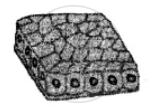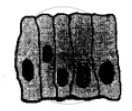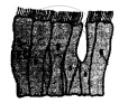Advertisements
Advertisements
Question
The body of sponges does not possess tissue level of organisation though it is made of thousands of cells. Comment.
Solution
Though all members of Animalia are multicellular, all of them do not exhibit the same pattern of organisation of cells. For example, in sponges, the cells are arranged as loose cell aggregates, i.e. they exhibit the cellular level of organisation. Some division of labour (activities) occurs among the cells. Hence, the body of sponges does not possess a tissue level of organisation.
APPEARS IN
RELATED QUESTIONS
Based on the following information, identify the three types of epithelial tissue in the figures given below :
| a |  |
b |  |
c |  |
(1) Cuboidal epithelium: It consists of a single layer of cuboidal cells.
(2) Columnar epithelium: It is composed of tall, cylindrical cells with oval nuclei usually placed at the base of the cells.
(3) Ciliated epithelium: It consists of cells being hair-like cilia on their free surface.
Name the tissues found
at the outer layer of skin.
Name the tissues found:
in the testes and ovaries.
Intestine absorb the digested food materials. What type of epithelial cells are responsible for that?
Give reasons for
Intercellular spaces are absent in sclerenchymatous tissues.
In a certain type of cell division, the diploid number of chromosomes is reduced to half. This kind of division occurs in ______.
______ epithelium is seen in sweat glands.
An epithelial layer does not allow the regulation of materials between the body and the external environment.
Write one point of difference between
Simple and compound epithelial tissue.
Write the salient features of the compound epithelium.
